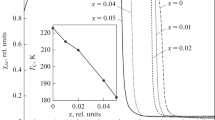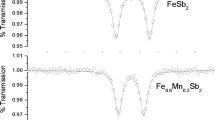Abstract
Mössbauer spectroscopy study of Ce(Fe1–x Si x )2 compounds with x = 0 and 0.07 was performed at different temperatures. Easy magnetization axis of the CeFe2 ferromagnet at 130 K was shown to be in the {110} plane and to deviate from the [001] axis by ∼10°. Upon cooling, the Ce(Fe0.93Si0.07)2 compound undergoes the ferromagnet–antiferromagnet phase transition in a temperature range of 120–125 K, which is accompanied by the reduction of the lattice symmetry. The Debye temperature of the Ce(Fe0.93Si0.07)2 compound was estimated using temperature dependences of the integral intensity of Mössbauer spectrum; it is T D ≈ 310 K. When analyzing the P(H) hyperfine field distributions P(H) derived from the Mössbauer spectra of Ce(Fe0.93Si0.07)2, it was found that in the cubic structure of this compound in the ferromagnetic state there occur local rhomboherdal distortions typical of the antiferromagnetic state.
Similar content being viewed by others
References
O. Eriksson, L. Nordstrom, M. S. S. Brooks, and B. Johansson, “4f-band magnetism in CeFe2,” Phys. Rev. Lett. 60, 2523–2526 (1988).
A. V. Deryagin, A. A. Kazakov, N. V. Kudrevatykh, V. N. Moskalev, N. V. Mushnikov, and S. V. Terent’ev, “Magnetic moment, magnetostriction and effective field at the nuclei of Fe in CeFe2, LuFe2 and their hydrides,” Fiz. Met. Metalloved. 60, 295–300 (1985).
L. Paolasini, B. Ouladdiaf, N. Bernhoeft, J-P. Sanchez, P. Vulliet, G. H. Lander, and P. Canfield, “Magnetic ground state of pure and doped CeFe2,” Phys. Rev. Lett. 90, 057201 (2003).
S. J. Kennedy, P. J. Brown, and B. R. Coles, “A polarized neutron study of the magnetic form factors in CeFe2,” J. Phys.: Condens. Matter 5, 5169–5178 (1993).
S. B. Roy and B. R. Coles, “Magnetic behavior of CeFe2: Effects of Ru, Rh, and Pd substitutions,” Phys. Rev. B: Condens. Matter 39, 9360–9367 (1989).
S. J. Kennedy and B. R. Coles, “The magnetic phases of pseudobinary Ce(Fe1-xMx)2 intermetallic compounds M = Al, Co, Ru,” J. Phys.: Condens. Matter 2, 1213–1222 (1990).
A. Haldar, N. K. Singh, Ya. Mudryk, K. G. Suresh, A. K. Nigam, and V. K. Pecharsky, “Temperature and magnetic field induced structural transformation in Sidoped CeFe2: An in-field X-ray diffraction study,” Solid State Commun. 150, 879–883 (2010).
A. Haldar, K. G. Suresh, and A. K. Nigam, “Magnetism in gallium-doped CeFe2: Martensitic scenario,” Phys. Rev. B: Condens. Matter Mater. Phys. 78, 144429 (2008).
V. S. Rusakov, Mössbauer Spectroscopy of Locally Heterogeneous Systems (Almaty, 2000) [in Russian].
U. Atzmony and M. P. Dariel, “Magnetic anisotropy and hyperfine interactions in CeFe2, GdFe2, and LuFe2,” Phys. Rev. B: Solid State 10, 2060–2067 (1974).
L. Paolasini, S. Di Matteo, P. P. Deen, S. Wilkins, C. Mazzoli, B. Detlefs, G. Lapertot, and P. Canfield, “Resonant magnetic X-ray scattering in the antiferromagnet Ce(Fe1–xCox)2,” Phys. Rev. B: Condens. Matter Mater. Phys. 77, 094433 (2008).
L. A. Stashkova, V. S. Gaviko, N. V. Mushnikov, and P. B. Terent’ev, “Hydrogen ordering in rare-earth intermetallic (Er, Tb)Fe2 compounds with giant spontaneous magnetostriction,” Phys. Met. Metallogr. 114, 985–991 (2013).
A. V. Vershinin, V. V. Serikov, N. M. Kleinerman, N. V. Mushnikov, E. G. Gerasimov, V. S. Gaviko, and A. V. Proshkin, “Magnetic phase transitions in the Ce(Fe1–xSix)2 compounds,” Phys. Met. Metallogr. 115, 1208–1215 (2014).
V. V. Ovchinnikov, N. V. Gushchina, and S. V. Ovchinnikov, “Mössbauer and resistometric study of α(bcc) → γ(fcc) phase transformation induced by ion bombardment and intraphase processes in the Fe + 8.25 at % Mn alloy,” Phys. Met. Metallogr. 116, 1234–1243 (2015).
L. Paolasini, P. Dervenagas, P. Vulliet, J-P. Sanchez, G. H. Lander, A. Hiess, A. Panchula, and P. Canfield, “"Magnetic response function of the itinerant ferromagnet CeFe2,” Phys. Rev. B: ondens. Matter Mater. Phys. 58, 12117–12124 (1998).
V. S. Rusakov, Foundations of Mössbauer Spectroscopy. A Tutorial (Fiz. Fac., Mosk. Gos. Univ., Moscow, 2011) [in Russian].
S. M. Dubel and W. Zinn, “Influence of Si on spin and charge density changes in bcc-iron,” J. Magn. Magn. Mater. 28, 261–276 (1982).
Author information
Authors and Affiliations
Corresponding author
Additional information
Original Russian Text © A.V. Vershinin, S.P. Naumov, V.V. Serikov, N.M. Kleinerman, N.V. Mushnikov, V.S. Rusakov, 2016, published in Fizika Metallov i Metallovedenie, 2016, Vol. 117, No. 12, pp. 1234–1240.
Rights and permissions
About this article
Cite this article
Vershinin, A.V., Naumov, S.P., Serikov, V.V. et al. Hyperfine-interaction parameters and magnetic phase antiferromagnet–ferromagnet transition in Ce(Fe1–x Si x )2 . Phys. Metals Metallogr. 117, 1185–1191 (2016). https://doi.org/10.1134/S0031918X16120176
Received:
Accepted:
Published:
Issue Date:
DOI: https://doi.org/10.1134/S0031918X16120176




